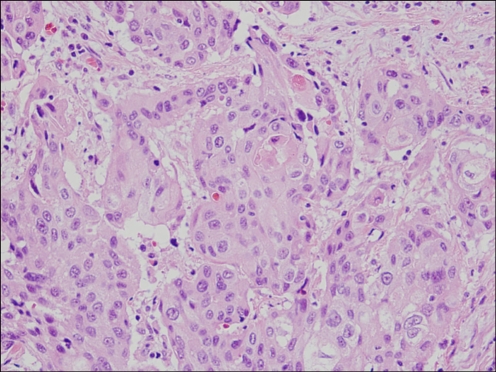Korean J Urol.
2010 Apr;51(4):287-290.
Spontaneous Intraperitoneal Bladder Perforation Associated with Urothelial Carcinoma with Divergent Histologic Differentiation, Diagnosed by CT Cystography
- Affiliations
-
- 1Department of Urology, Kyung Hee University Graduate School of Medicine, Seoul, Korea. chlee@khu.ac.kr
Abstract
- Spontaneous bladder perforation is a very rare event. Prompt diagnosis of this injury is very important, particularly with intraperitoneal perforation, because mortality increases if surgical repair is delayed. Previous studies have reported that plain cystography is the primary modality of imaging study rather than relatively insensitive computed tomography (CT) when bladder perforation is suspected. We report here a rare case of spontaneous intraperitoneal perforation of the bladder associated with urothelial carcinoma with divergent histologic differentiation, as diagnosed with CT cystography.
Figure
Reference
-
1. Evans RA, Reece RW, Smith MJ. Idiopathic rupture of the bladder. J Urol. 1976; 116:565–567. PMID: 978806.
Article2. Bastable JR, De Jode LR, Warren RP. Spontaneous rupture of the bladder. Br J Urol. 1959; 31:78–86. PMID: 13651652.
Article3. Deck AJ, Shaves S, Talner L, Porter JR. Computerized tomography cystography for the diagnosis of traumatic bladder rupture. J Urol. 2000; 164:43–46. PMID: 10840421.
Article4. Holmäng S, Kleist H, Lundstam S, Borghede G. Spontaneous perforation of the bladder after external beam radiotherapy for bladder carcinoma. J Urol. 1996; 155:645. PMID: 8558686.5. Sivit CJ, Cutting JP, Eichelberger MR. CT diagnosis and localization of rupture of the bladder in children with blunt abdominal trauma: significance of contrast material extravasation in the pelvis. AJR Am J Roentgenol. 1995; 164:1243–1246. PMID: 7717239.
Article6. Budd JS. Spontaneous intraperitoneal rupture of the bladder in association with transitional cell carcinoma. Postgrad Med J. 1988; 64:165–166. PMID: 3174533.
Article7. Skolarikos A, Chrisofos M, Ferakis N, Papatsoris A, Dellis A, Deliveliotis C. Does the management of bladder perforation during transurethral resection of superficial bladder tumors predispose to extravesical tumor recurrence. J Urol. 2005; 173:1908–1911. PMID: 15879773.
Article8. Wasco MJ, Daignault S, Zhang Y, Kunju LP, Kinnaman M, Braun T, et al. Urothelial carcinoma with divergent histologic differentiation (mixed histologic features) predicts the presence of locally advanced bladder cancer when detected at transurethral resection. Urology. 2007; 70:69–74. PMID: 17656211.
Article
- Full Text Links
- Actions
-
Cited
- CITED
-
- Close
- Share
- Similar articles
-
- The Role of Computerized Tomography in the Diagnosis of Bladder Rapture
- A Case of Peritonitis Induced by Urinary Ascites Due to Spontaneous Intraperitoneal Bladder Rupture
- The Diagnostic Value and Use of Computerized Tomography in Bladder Rupture
- Spontaneous Bladder Perforation in a Patient with a Long-Term Intraurethral Catheter
- Urothelial Carcinoma in a 17-year-old Boy





